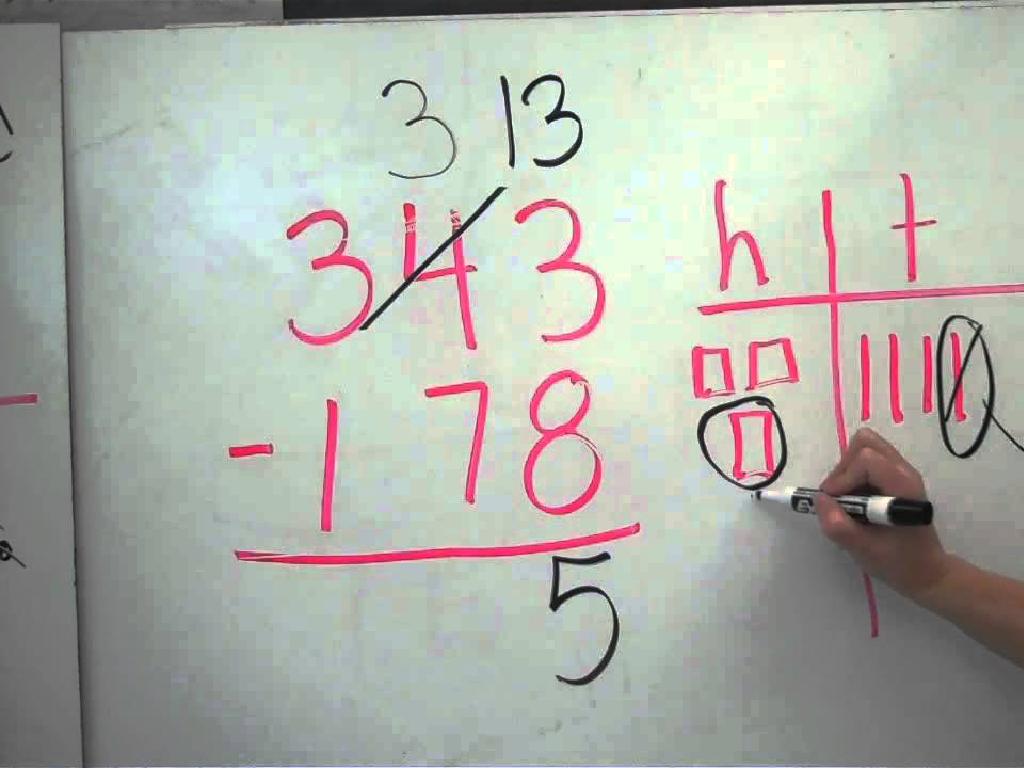Order Fractions With Like Numerators Or Denominators
Subject: Math
Grade: Fourth grade
Topic: Compare And Order Fractions
Please LOG IN to download the presentation. Access is available to registered users only.
View More Content
Ordering Fractions: Like Numerators & Denominators
– Fractions represent parts of a whole
– Imagine a pizza cut into slices; each slice is a fraction of the pizza
– Today’s goal: ordering fractions
– We’ll learn to arrange fractions from smallest to largest
– Comparing fractions with like parts
– Like numerators: same top number; like denominators: same bottom number
– Importance of fraction ordering
– Ordering helps in understanding amounts and solving problems
|
This slide introduces students to the concept of fractions as parts of a whole, using relatable examples like slices of pizza. The goal for today’s lesson is to learn how to order fractions that have either the same numerator (top number) or the same denominator (bottom number). Understanding how to compare and order fractions is crucial as it aids in grasping the relative sizes of different fractions and is a foundational skill for more advanced math concepts. Activities will include hands-on examples and practice problems where students will arrange fractions in order, enhancing their comprehension of the topic.
Quick Review: Understanding Fractions
– A fraction shows part of a whole
– Like a slice of pizza is a part of a whole pizza
– Numerator and denominator explained
– Top number (numerator) is the part you have, bottom number (denominator) is the total parts
– Example fractions: 1/2, 3/4, 5/8
– Common fractions we see in daily life, like half an apple (1/2) or three quarters of a pizza (3/4)
|
Begin with a simple explanation that a fraction represents a part of a whole, using tangible examples like slices of pizza to illustrate the concept. Clarify the roles of the numerator and denominator, ensuring students understand that the numerator indicates how many parts are being considered, while the denominator shows the total number of equal parts in the whole. Provide common examples of fractions to help solidify their understanding. This foundational knowledge will be crucial as they learn to compare and order fractions with like numerators or denominators.
Ordering Fractions with Like Numerators
– Fractions with the same top number
– Example: 3/4, 3/5, 3/8
– All fractions have 3 as the numerator
– Comparing fractions with like numerators
– Look at the denominators to compare
– Determining the larger or smaller fraction
– The larger the denominator, the smaller the fraction’s value
|
This slide introduces students to the concept of comparing fractions that have the same numerator. Begin by explaining that the numerator, or top number, represents how many parts we have. Then, use the examples provided to show that even though the numerators are the same, the size of the fraction can differ due to the denominator. Teach the students that with like numerators, the fraction with the larger denominator is actually the smaller fraction because the whole is divided into more pieces. Have students practice by ordering the given examples from smallest to largest and explain their reasoning. This will help solidify their understanding of the relationship between the numerator and denominator in fractions.
Ordering Fractions with Like Numerators
– Rule for like numerators
– Smaller denominator means a larger fraction
– Example: Comparing fractions
– 3/4 is larger than 3/8 because 4 < 8
– Practice ordering fractions
– Arrange 3/4, 3/8, 3/5 by size
|
This slide introduces the concept of comparing fractions with the same numerators. Emphasize that when fractions have the same numerators, the size of the denominator will determine which fraction is larger; the smaller the denominator, the larger the fraction. Use the example provided to illustrate this rule clearly. For the practice activity, guide students to apply this rule to order the fractions 3/4, 3/8, and 3/5 from largest to smallest. Encourage them to think about the size of the pieces the denominator represents and how that affects the overall size of the fraction. This will help solidify their understanding of the relationship between the numerator, the denominator, and the value of a fraction.
Ordering Fractions with Like Denominators
– Fractions with same denominators
– Example: 1/6, 4/6, 5/6
– These fractions all have 6 as the denominator
– Comparing fractions
– Which is smallest or largest?
– Ordering by numerator size
– The larger the numerator, the larger the fraction
|
This slide introduces students to the concept of comparing and ordering fractions that have the same denominator. Start by explaining that the denominator represents the total number of equal parts the whole is divided into. With like denominators, the size of the parts is the same, so we compare the numerators to determine the size of the fractions. Use the example provided to illustrate how 1/6 is smaller than 4/6 and 5/6 because it has fewer parts of the whole. Encourage students to think of the numerators as pieces of a pie – the more pieces you have, the more of the pie you get. This will help them understand why a fraction with a larger numerator is greater when the denominators are the same.
Ordering Fractions with Like Denominators
– Rule for like denominators
– Fractions with the same bottom number (denominator) are easy to compare.
– Larger numerator means larger fraction
– If two fractions have the same denominator, look at the top number (numerator) to decide which is bigger.
– Example: Comparing 5/6 and 1/6
– 5/6 is bigger than 1/6 because 5 is more than 1.
– Practice ordering: 1/6, 4/6, 5/6
– Put these in order by looking at the numerators: 1/6 (smallest), 4/6, 5/6 (largest).
|
This slide introduces the concept of comparing fractions with like denominators. Emphasize that when fractions have the same denominator, the comparison can be made by looking at the numerators the larger the numerator, the larger the fraction. Use the example provided to illustrate this point. For the practice activity, guide the students to order the fractions from smallest to largest by comparing their numerators. This will help solidify their understanding of the rule and prepare them for more complex fraction comparisons.
Let’s Practice Together!: Ordering Fractions
– Activity: Ordering Fractions
– Collaborative class exercise
– We will work in groups to order fractions
– Apply rules for ordering fractions
– Remember: same denominators? Look at numerators!
– Share and compare answers
– Discuss your results with the class
|
This slide introduces a class activity focused on ordering fractions, which is a practical application of the rules the students have learned. The activity is designed to be collaborative, encouraging students to work together and use their collective knowledge to order sets of fractions. Remind students to consider the numerators when the fractions have like denominators and vice versa. After completing the exercise, students will share their answers with the class to compare and learn from each other. For the teacher: Prepare fraction sets in advance, ensure each group has a different set to promote a variety of examples during the sharing session. Possible activities include ordering fractions from least to greatest, greatest to least, or even creating a number line with fractions. Encourage students to explain their reasoning for the order they chose, reinforcing their understanding of the concept.
Class Activity: Fraction Ordering Challenge
– Pair up for a fraction challenge
– Order fractions on your worksheet
– Apply rules for like numerators/denominators
– If denominators are the same, the fraction with the smaller numerator is smaller
– Share your findings with the class
|
This activity is designed to reinforce the concept of ordering fractions by having students work in pairs to complete a worksheet. The worksheet should contain sets of fractions with either like numerators or like denominators. Remind students of the rules: when fractions have the same denominator, the one with the smaller numerator is the smaller fraction; when they have the same numerator, the fraction with the larger denominator is smaller. After completing the activity, each pair will share their answers, allowing for discussion and clarification of any misconceptions. Possible variations of the activity could include ordering fractions from smallest to largest, largest to smallest, or even mixing the sets to include both like numerators and denominators.
Conclusion & Reflection: Ordering Fractions
– Recap on ordering fractions
– We learned how to arrange fractions with same numerators or denominators.
– Understanding the usefulness
– Ordering fractions helps in everyday decisions like cooking or comparing sizes.
– Homework assignment
– Reflect on today’s learning
– Think about how this skill can help you in real life.
|
Today, we’ve explored how to order fractions with like numerators or denominators, which is a key skill in understanding and comparing different quantities. Students should now appreciate the practical applications of this skill, such as in measuring ingredients for a recipe or determining the longest duration of activities. For homework, students will reinforce their understanding by completing a worksheet that requires them to order sets of fractions. Encourage them to reflect on what they’ve learned and consider how they might use these skills outside of the classroom. This reflection will help solidify their understanding and see the value in what they’ve learned.






